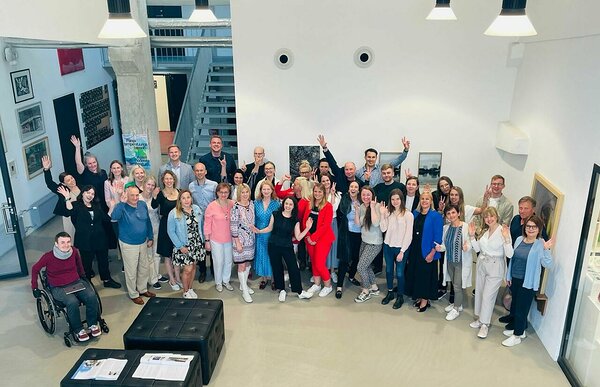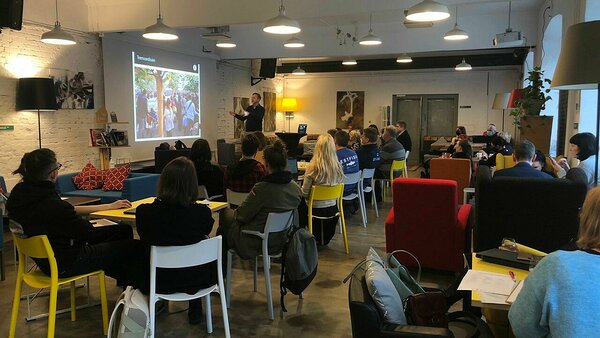What Value Does a Service Design Master Class Create for a Company?
A total of 48 tourism companies completed the Master Class by Enterprise Estonia on Service Design and Digitalisation of Services for Tourism Companies from January 2022 to June 2023. A total of 25 excellent Estonian service design mentors attended the master class. Among them is Kairi Loomet, who wrote her master's thesis on the subject, in which she analysed the impact of participation in the master class on companies and created an appropriate evaluation system for future classes and programmes of a similar format. Loomet mentored the following companies: Wanderlust Hikes (winner of the 2nd group), Hara Harbor, Pönka Guesthouse and Valgeranna Adventure Park.
Group 4 of the Master Class on Service Design and Digitalisation of Services for Tourism Companies
The impact of design on corporate income and competitiveness
The purpose of using service design is to provide a user-friendly, competitive and relevant service based on the needs and expectations of customers. In order to provide the perfect visitor experience, services must be designed comprehensively (Stickdorn & Schneider 2010). Service design is therefore necessary for both the client and the organization itself.
The McKinsey consulting firm surveyed 300 companies from different sectors and countries over a period of five years. It turned out that those who used higher level design earned 32% more revenue compared to other companies in their respective industries.
The purpose of the master class and the results seen in tourism companies
The aim of the service design master class was to promote the use of service design and the digitalisation of services in Estonian tourism companies in order to increase the export and innovation capacity of the companies and the attractiveness of the tourism services on external markets.
As a result of the master class, the companies completed new tourism service prototypes. In addition, participants gained the practical experience of working with a service designer and the knowledge on how to use data and digital solutions in the development and management of their business processes.
“The decision to participate in the master class derived from the fact that we wanted to develop services that would be even more awesome, while recognizing that additional knowledge, tools and guidance were necessary in order to design these new services. The program seemed the exact fit for us in order to implement design thinking across the company and develop digital solutions that would suit our customers,” said Reimo Mürgimäe of Wanderlust, winner of the 2nd group of the master class.
Individual and organizational development through design thinking
The study conducted as part of Kairi Loomet's master's thesis showed that thanks to the master class, the design thinking of all participants developed at an individual level — they learned about new tools and there was a change in their way of thinking. At the organizational level it was seen that the majority of companies integrated design thinking into their processes and work culture, and half of the companies achieved commercial success through design thinking.
It also turned out that digitalisation affects most companies and, in their opinion, contributes to an increase in internal efficiency, an increase in external opportunities and, in some cases, a downright shocking change. The main obstacles regarding digitalisation were, above all, the lack of time and financial resources, as well as lack of knowledge and courage.
According to Kaire Mertsin, head of the Pernova Education Center, winner of the 3rd group of the master class, their goal was to focus more on increasing the number of foreign visitors: “At that point, the centre was already partially digitalised and provided an opportunity for a visitor experience in another language besides Estonian, yet we did not have a well-thought-out customer journey that would help visitors reach us and to also find something that would be valuable and would prolong the experience for them. Our end result was a complete customer journey, starting from our new mascot Kratt on the border of the city, and from improving the visitor experience through the directional signs and floor plans, to the so-called interactive experience book that can be taken with you digitally as an extension of the experience”.
The experience and results of the master class
Külli Eller, the hostess of the Piesta Kuusikaru farm, winner of the fourth group of the master class, commented on her experience as follows:
“As part of the master class, we specifically took a close look at the needs of families with children. We were surprised to find out that they wanted to spend more time in Piesta, which is why the self-service farm tour, the first idea that we narrowed down to, developed into an entire four-hour educational experience, a journey from growing and preparing food to exciting flavors. The plan is to further develop the specific prototype.”
According to Eller, they participated in the master class in order to hear the opinion of a professional, to develop creative thinking, and to acquire a mindset or the tools that would help with the developments both today and in the future.
Development of the use of design in organizations as influenced by the master class
In the study conducted as part of the master's thesis, it was evaluated how, among the participating companies, the use of design – based on the combined model of the Design Ladder – in the organization when entering the master class differed from the use of design after leaving the master class. Most companies placed themselves on the first (non-design) or second rung (design as styling) when they came to the master class, and after the master class they had advanced by a rung or two, that is, to the second or third rung (design as process), only one company reached the last, fourth rung (design as strategy).
On an individual level, the main values of the master class were considered to be, above all, new knowledge, skills and the change in one’s mindset, as well as the opportunity for self-realization. At the organizational level, the main values were thought to be the change in attitudes and the emergence of a common language within the team, thanks to the use of the same tools and methods. What the two levels had in common was the value in the emergence of new energy along with an increase in motivation, and creating new connections and collaborating with other participants were considered important.
“Rummu visitors are our best marketers,” says Mariane Barrier, winner of group 1 of the master class and the Marketing & Destination Development Manager (Translator’s notes: Chief Executive Officer since August 2023) at RUMMU Quarry I Prison. “With the implementation of the prototype created as part of the master class, Rummu can now use a smart web application that adds a whole new dimension to the visit.”
The next steps to take to ensure the sustainability of design thinking
In the summary of her work, Loomet proposes a series possible actions that would inspire the participants to continue using design thinking even after the end of the programme:
- regular follow-up meetings and activities;
- mentor support even after the programme;
- the creation and demonstration of possible additional support and training programmes to encourage the consistent implementation of new knowledge as well as to help identify opportunities to implement a prototype and/or a new business model.
Based on her experience as a mentor, Kairi Loomet commented:
“Participating in the master class was certainly very valuable for companies — that could be seen from the change in the mindset of the participants, and from learning new tools, to implementing the prototypes. It is very important to encourage participants to continue using design thinking after leaving the master class, so that it could spread and take root on an organizational level and thus bring them a competitive advantage.”
Master Class Training Days at Palo Alto Club
In conclusion
The purpose of using service design is to provide users with a user-friendly, competitive and relevant service based on their needs and expectations. According to a McKinsey study, companies that actively use design, earn 32% more revenue compared to other companies.
The aim of the master class held in Estonian tourism companies was to promote the use of service design and digitalisation in order to increase the export and innovation capacity and attractiveness in foreign markets. As a result of the master class, each participant completed a new tourism service prototype, and the participants gained practical experience and knowledge on the use of digital solutions in the development of business processes.
The study showed that the master class helped develop design thinking on an individual level and to integrate it into the processes of the organization. Thanks to the master class, most companies advanced in the use of design by a rung or two on the Design Ladder, thus reaching the rung of ‘design as process’. Participants considered the values of the master class to be the new knowledge, skills and mindset, and, on an organizational level, the change in attitudes and improvement in teamwork.
///
The Master Class on Service Design and Digitalisation of Services for Tourism Companies was commissioned by Enterprise Estonia, and the master class was conducted by the Estonian Design Centre in cooperation with 25 service design mentors and 11 trainers. The master class was supported by the European Regional Development Fund.

